Rasmussen University Client-Centered Care 1 Exam 2 concept
guide 2023/2024
Vitamin A - Correct Answer Found in chicken livers, sweet potato with skin, carrots, spinach, and pumpkin. Deficiency causes night blindness, exophthalmia, and decreased immunity
Vitamin D - Correct Answer Found in tuna fish, whole or fortified milk, fortified soy milk, and fortified cereal.
Deficiency causes rickets, osteomalacia, and osteoporosis
Vitamin K - Correct Answer Found in green leafy vegetables, tuna fish, and tomato sauce.
Deficiency causes hemorrhagic disease (newborn) and defective blood clotting
Thiamin (B1) - Correct Answer Found in pork, beef, whole grains, and legumes
Deficiency causes beriberi, neuropathy, Wernicke-Korsakoff syndrome (alcoholism)
Riboflavin (B2) - Correct Answer Found in milk products, organ meats, enriched grains and cereals
Deficiency causes cheilosis, glossitis, seborrheic dermatitis
Niacin (B3) - Correct Answer Found in meat and dairy, peanuts, enriched grains and cereals Deficiency causes pellagra, weakness, scaly dermatitis and neuritis
Vitamin B6 (pyridoxine) - Correct Answer Found in meat, organ meats, legumes, bananas, and potatoes Deficiency causes hypochromic anemia and CNS abnormalities
Vitamin B12 (cobalamin) - Correct Answer Found in meat, milk, cheese, egg, fortified cereals and juices Deficiency causes pernicious anemia, and neural tube defects in pregnancy
Phosphrous - Correct Answer Formation of bones and teeth, participates in absorption of glucose. Found in milk, cheese, meats, egg yolk, whole grains, legumes and nuts. Requires 700 mg/day
Deficiency causes hypophosphatemia, weakness, loss of appetite, fatigue and pain
Risks for dehydration & diseases - Correct Answer Kidney infections, kidney stones, gallstones, and constipation, can advance to death, may adversely influence cognitive function and mood
Risks for fluid volume overload (Hypervolemia) - Correct Answer Kidney disease, congestive heart failure and liver disease. Symptoms: Edema (puffiness), puffy eye lids, swollen hands, bounding pulse, rapid weight gain, cramping, swelling in abdomen, headache, shortness of breath, high blood pressure and fatigue.
Energy needs - Correct Answer Energy must come from outside source (food). Macronutrients supply energy in form of calories, fat supplies most energy per gram. Involuntary body work uses most energy (circulation, respiration, digestion, absorption and other internal activities that maintain life. Voluntary work and exercise: conscious activities of daily living and physical activity
BMI - Correct Answer Calculated using weight and stature. BMI = weight(kg)/stature(m^2)
Dietary guidelines for Americans - Correct Answer *Follow a healthy eating pattern across the lifespan
*Focus on variety, nutrient density and amount
*Limit calories from added sugars and saturated fats and reduce sodium intake *Shift to healthier food and beverage choices *Support healthy eating patterns for all
A & P musculoskeletal - Tendon & Osteoblast - Correct Answer *Tendon- dense fibrous connective tissue that connects muscle to bone and is capable of withstanding tension and transmit the mechanical forces of muscle contraction to the skeletal system
*Osteoblast- cells that form new bone, can come from bone marrow, related to structure
cells, one nucleus, produce new bone called "osteoid" which is made of bone collagen and other protein
Injuries - Sprain, Skeletal Traction, & Contractures - Correct Answer *Sprain- stretching or tearing of ligaments, the fibrous tissue that connects bones and joints
*Skeletal Traction- treatment method for broken bones, combination of pulleys, pins, and weights used to promote healing of the fractured bone, a pin is placed inside the bone, pin provides a base for a pulley system
*Contractures- fixed tightening of muscle, tendons, ligaments, or skin; prevents normal movement of associated body parts such as a severe burn
Complications related to fractures and interventions - Correct Answer Delayed union (fracture takes longer than normal to heal), malunion (fracture does not heal in normal alignment), non-union (fracture does not heal), joint stiffness, contractures
Arthritis - Correct Answer Inflammation of one or more joints, causing pain and stiffness that can worsen with age. Each type of arthritis has different causes, infections and underlying diseases
Proper Body mechanics - Correct Answer Feet should be apart with one foot slightly in front of the other, keep back straight, bend from hips and knees, do not bend at the waist, life objects using arm and leg muscle, hold object close to body and at waist level




